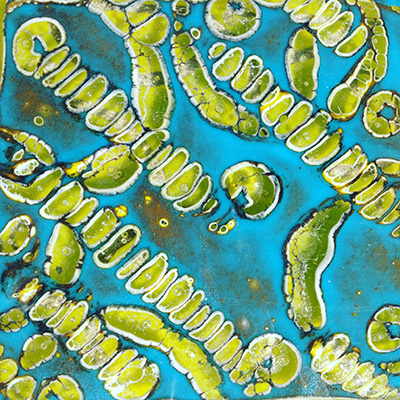The Medium With A Message: Hazel MacLennan’s Environmentally-Conscious Hand Blown Art Glass
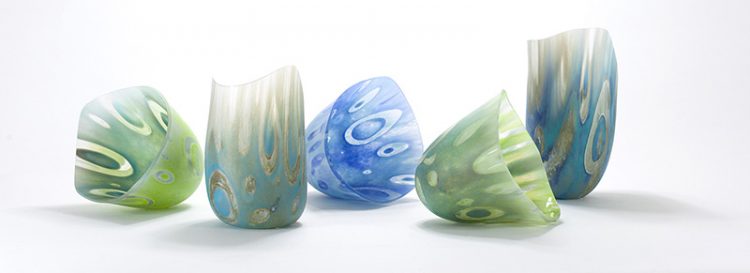
Any collector of hand blown art glass knows that this art form has the power to deeply enrich our lives on an individual level. In brightening and beautifying our homes, blown glass uplifts our minds and our spirits, creating an oasis of peace and rejuvenation. In the hands of artists like Hazel MacLennan, however, art glass can do even more: It can become a vessel for ideas and an agent of social change.
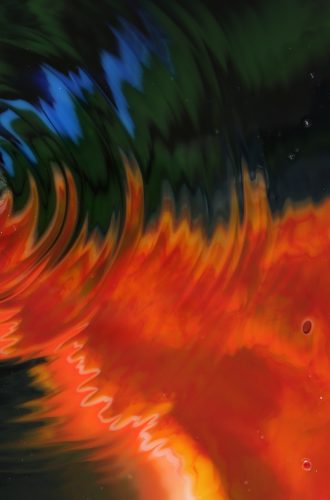 One of the greatest challenges we face as a society today is that, ironically, the more connected we become, the more difficult it is to personally connect with issues that affect us as a global whole. Problems like climate change, the pollution and destruction of the world’s oceans, and mass extinctions seem too vast, complicated, and overwhelming to process. Lost in a sea of data and linked to a 24-hour stream of chaotic and troubling events, many of us detach from the problems facing our planet, assuming the situation is hopelessly beyond us even before we have made a meaningful effort to effect change. Instead, we distract ourselves, resign ourselves, or look to populist leaders who appear to offer easy answers to complex problems.
One of the greatest challenges we face as a society today is that, ironically, the more connected we become, the more difficult it is to personally connect with issues that affect us as a global whole. Problems like climate change, the pollution and destruction of the world’s oceans, and mass extinctions seem too vast, complicated, and overwhelming to process. Lost in a sea of data and linked to a 24-hour stream of chaotic and troubling events, many of us detach from the problems facing our planet, assuming the situation is hopelessly beyond us even before we have made a meaningful effort to effect change. Instead, we distract ourselves, resign ourselves, or look to populist leaders who appear to offer easy answers to complex problems.
Within this maelstrom, all forms of art have the ability to cut through the digital ‘noise’ that surrounds us and provide a link between individual people and broader issues. Art evokes emotion and therefore inspires a sense of meaning. Art starts real-time conversations. Art connects people even as it divides opinions.
It is this power that glass artist Hazel MacLennan hoped to draw on with her seminal collection of hand blown art glass, Oceanic Pollutants. Though at first glance MacLennan’s works appear to be expertly-crafted vases and dishes that swirl with a range of vivid colours—from sea and earth greens to wild shocks of crimson and smokey midnight blues—each one contains intricate details that hint at a deeper message of environmental conservation.
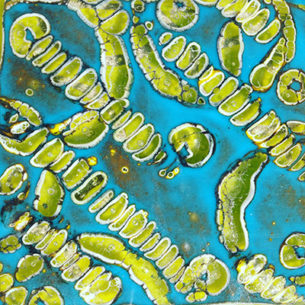 Oceanic Pollutants, MacLennan’s final fourth year project at University, was inspired first and foremost by the artist’s love of the sea (which she describes as the ‘life blood of planet Earth’) and her desire to protect it. To that end, she devoted untold hours to creating three different collections of hand blown art glass, each focusing on a particular type of oceanic pollutant: Toxic pollution, oil pollution, and plastic.
Oceanic Pollutants, MacLennan’s final fourth year project at University, was inspired first and foremost by the artist’s love of the sea (which she describes as the ‘life blood of planet Earth’) and her desire to protect it. To that end, she devoted untold hours to creating three different collections of hand blown art glass, each focusing on a particular type of oceanic pollutant: Toxic pollution, oil pollution, and plastic.
Speaking on how she shaped the first collection (Toxic Pollution) and what, exactly, it represents, MacLennan explained that, ‘Every day humans pump chemical, radioactive, and sewage matter into our oceans. I created three drop out vessels slumped over naturally beautiful stones to represent the effect toxic pollution is having on our beaches and our lands.’ Though the motif behind these uniquely curvaceous mixed-media vessels is dark, the pieces themselves flow so naturally that the observer almost expects them to begin swaying like seaweed. This in itself is an apt expression of the effects of toxic pollution, which are not always immediately and visually obvious. A radioactive lake, for example, may look crystal clear and be surrounded by waving grass; it’s only when one notices the strange silence where birds and insects ought to be that anything seems amiss.
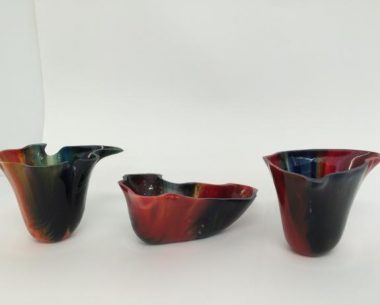 For the second series in her collection, Oil Pollution, MacLennan ‘Focused on the three largest spills which have happened in the last few decades: The BP Deepwater Horizon spill off the Gulf of Mexico, the Shell spill in 2008 which occurred in the beautiful Niger Delta, and the Kuwait Oil fires in 1991,’ all of which, ‘Caused devastating effects to our environment.’ To represent these dramatic events, MacLennan chose bolder hues, creating pieces of colour-pooled hand blown art glass that utilise a drop out technique to ‘Make each vessel the exact satellite trajectory of each spill.’
For the second series in her collection, Oil Pollution, MacLennan ‘Focused on the three largest spills which have happened in the last few decades: The BP Deepwater Horizon spill off the Gulf of Mexico, the Shell spill in 2008 which occurred in the beautiful Niger Delta, and the Kuwait Oil fires in 1991,’ all of which, ‘Caused devastating effects to our environment.’ To represent these dramatic events, MacLennan chose bolder hues, creating pieces of colour-pooled hand blown art glass that utilise a drop out technique to ‘Make each vessel the exact satellite trajectory of each spill.’
Finally, MacLennan chose to tackle plastic pollution, which she feels is the largest and most dangerous threat to our oceans at present. From the Pacific ‘garbage patch’ that is now the size of the state of Texas to the tiny particles that are poisoning fish, birds, and ultimately human beings, plastic is a gathering menace that we ignore at our peril. To represent the contrast between the ocean’s natural purity and the ‘dirtiness’ of plastic, MacLennan created a clear glass cast with a cavity in the middle. The cavity, which is shaped like a cast-off plastic bottle, is misty and opaque. While many of the other pieces in Oceanic Pollutants are highly symbolic and interpretive, the message behind ‘Plastic’ is more literal and distinct.
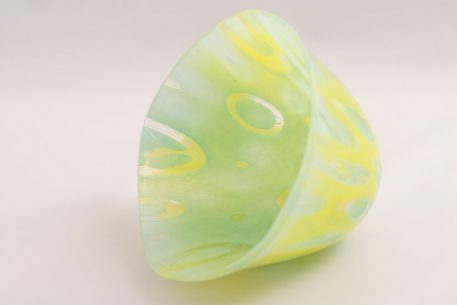 Through the unconventional yet striking beauty of Oceanic Pollutants, MacLennan hopes to awaken viewers to the importance of protecting the birthplace and wellspring of all life on Earth: The ocean. She intends to forge a tangible bond between individual lives and the planet they reside on. Rather than relying on daunting numbers or shocking headlines to incite compassion, her work invites a simple and poignant exploration of beauty under fire. As artist and designer Olafur Eliasson so aptly put it, ‘Art does not show people what to do, yet engaging with a good work of art can connect you to your senses, body, and mind. It can make the world felt. And this felt feeling may spur thinking, engagement, and even action.’
Through the unconventional yet striking beauty of Oceanic Pollutants, MacLennan hopes to awaken viewers to the importance of protecting the birthplace and wellspring of all life on Earth: The ocean. She intends to forge a tangible bond between individual lives and the planet they reside on. Rather than relying on daunting numbers or shocking headlines to incite compassion, her work invites a simple and poignant exploration of beauty under fire. As artist and designer Olafur Eliasson so aptly put it, ‘Art does not show people what to do, yet engaging with a good work of art can connect you to your senses, body, and mind. It can make the world felt. And this felt feeling may spur thinking, engagement, and even action.’
SEE MORE OF HAZEL’S WORK HERE

